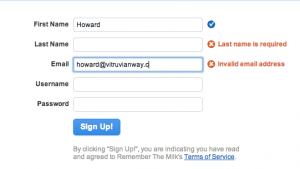Gamification in Marketing: Lessons from the Khan Academy Website
Warning: Use of undefined constant blog - assumed 'blog' (this will throw an Error in a future version of PHP) in /home/www/vitruvianadvertising.com/wp-content/themes/vitruvian/functions.php on line 1049
by Howard Jacobson.
In 2011, my family and I spent a year in a remote region of South Africa. My children homeschooled and I was nervous about being their math teacher, until we discovered KhanAcademy.org. Through our experience with their site, I learned valuable gamification tips marketers can use to better connect and answer their website audience’s needs.
If you’re unfamiliar, the site offers thousands of short videos designed to help visitors learn math, science, economics, history, and dozens of other subjects on their own. Founded by former hedge fund manager Sal Khan, the Academy offers free learning material to students worldwide. A registered non-profit, it is supported by the likes of Google, the Bill & Melinda Gates Foundation and Oracle.
Most of the math videos at Khan Academy are less than five minutes long and come with exercises by way of sets of ten problems, to test proficiency in that topic. Students can use an online scratch pad to arrive at their answers, which they enter in a box to the right of the problem.
A correct answer produces an immediate happy face, as well as movement on the multicolored progress bar. Do the problems quickly enough and the site rewards you with a “Picking Up Steam” badge worth 100 points, which you can share with your friends via email, Facebook, or Twitter.
My kids aren’t particularly math-phobic, but the subject has definitely not been as much fun as Facebooking, watching agonizingly slow-streaming Modern Family episodes on Hulu, reading, or even doing nothing. So I was shocked to witness them spending hours doing Khan Academy problem sets.
They loved the mouse-controlled scratchpad, even though a pencil and paper is much easier. They loved the “Correct! Next Question…” button with a smiley face. They loved the progress bar, the popup rewards, and the accumulation of points and badges. They even loved the tension at that moment when they entered their answer, knowing that an incorrect response would reset their current streak back to zero.
My kids became slightly addicted to math.
As a professional who helps people make money with their website, I was intrigued. What makes this site so successful—more successful than most of the math teachers and live classroom settings of which I’m aware?
Several brilliant features jump out at me, such as the clear and useful content, the engaging personality of the host and teacher, Sal Kahn, and their strategic use of technology to serve function, rather than dictating it.
But the most powerful elements are instant feedback and cumulative rewards, two of the fundamental elements of game design. Basically, Khan Academy’s math program is a video game, where the content happens to be solutions to equations. Instead of blowing up aliens or driving cars through urban war zones, players race against time to solve problems correctly.
Each answer is immediately scored right or wrong. Correct answers get happy faces and accumulate points. Mistakes get round yellow sad faces, but you still have to get the answer right before progressing to the next problem. You can ask for a hint (that resets your streak) or watch the video that covers the topic you’re practicing (no penalty for that).
Users immediately know what they did well and where they messed up. Compare that to your typical math test in high school; by the time you got the corrected test back, you couldn’t remember, much less care about, the questions and answers.
The positive feedback builds on itself cumulatively, so the stakes increase with each correct answer. Instead of fading or zoning out, as I did so many times in long math classes, my kids get more engaged and determined as their streak increases and they have more to lose.
When they achieve milestones, they are invited and encouraged to share their success with their Facebook community. Most of these milestones are predictable: you need so many energy points to win each level of badge, beginning with the meteorite badge. That’s in keeping with motivation theory: give people a clear path to success.
But Khan Academy also offers Black Hole badges (legendary and unknown, they are the most unique Khan Academy awards). Just as animal trainers discovered that unpredictable rewards sprinkled in with predictable ones increased dedication and speed of learning, Khan Academy tantalizes students with the promise of a “legendary and unknown” treasure, to generate fanatical devotion and commitment. Students aren’t just doing math; they’re engaged in an epic quest.
You’re probably not teaching math. What about instant feedback and cumulative rewards is applicable to your website?
1. Apply Operant Conditioning to the ‘Tiny Conversion’ Opportunities on Your Website
Operant conditioning means you reward behaviors and outcomes that please you and either punish or ignore outcomes that do not. The big outcome most website owners want is a lead or a sale, but focusing on that level is like trying to get your seal to balance a beach ball on his nose solely by rewarding him when he is balancing the beach ball on his nose. You could wait a long time for that to happen by itself.
Instead, the seal trainer focuses on mini-outcomes that precede, predict, and lead to the big outcome. Touching the ball with his nose, not flinching when you chuck the ball at him, etc.
On your website, treat every visitor engagement with a button, link, form, and scroll bar as a micro-conversion, a mini-outcome leading to the desired one. Every click should be rewarded. Children like badges. Seals like herring. What exactly does your visitor want at the moment they click the “learn more” link? Figure it out and give it to them.
The delicious irony about operant conditioning is its mutuality. More than you training your visitors, if you’re willing to pay attention, your visitors will train you to give them what they want.
2. Begin With a Gentle Slope
Putting cash in an envelope is extremely hard. Writing a check is very hard. Giving an unknown online merchant your credit card number is hard. Giving someone your email address and phone number is pretty hard. Even an email-only form will meet with resistance.
Don’t lead with those micro-conversions unless you’ve already built a relationship of trust with your visitor. Yes, people buy within a few minutes of landing on Amazon, Etsy, and eBay, but you’re none of the above. Unless your brand or prior relationship has already earned their trust, save those forms of engagement for later in the sales process.
What are the “meteorite badge” equivalents on your website? Watching an introductory video as a reward for clicking the play button? Landing on a page with helpful resources and links? Getting useful data from an online calculator? Viewing high-res images of your products?
3. Include Small Rewards in Your Opt-in Form
Once you think they’re ready to give you a way to stay in touch in exchange for immediate value (like giving their email in exchange for a free report), use a form that includes some gamification features.
The most common is feedback about the visitor’s success or failure in completing each field of the form. As the visitor tackles the field, they receive the equivalent of either a smiley face or a sad face. Here’s an example from the signup form for RememberTheMilk.com:
It may not seem like a big deal, but I found myself wanting to convert the red Xs into blue checkmarks, both when I first signed up for the service, and just now when I purposely left fields incomplete to generate the screenshot.
The small rewards are not meaningful enough to get me to do anything I don’t already want to do. It’s not like you could use checks and Xs to get me to sign up for the Miley Cyrus Online School of Dance. Yet they grease the skids and provide tiny momentum boosts that can keep me going in the face of momentary hesitation or unanticipated interruption.
Your website may not be as popular as Khan Academy, but you can still employ elements of game design to engage and encourage your visitors to ramp up their interactions.
This article by Howie Jacobson was originally posted on Search Engine Watch.


